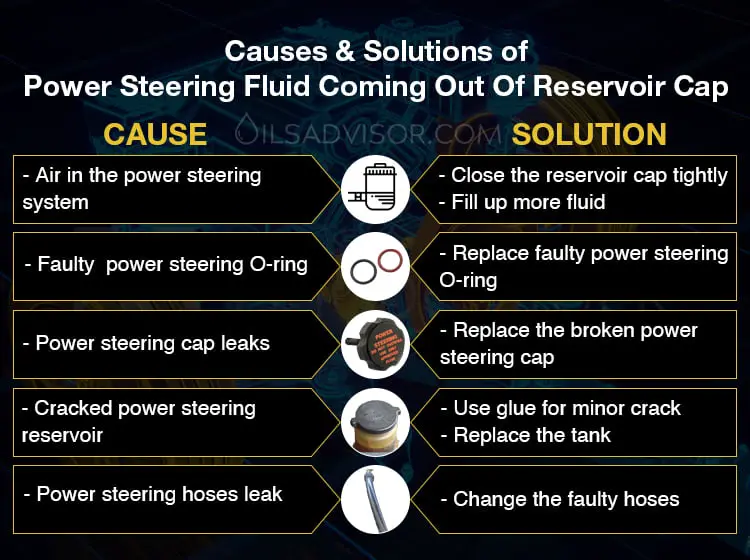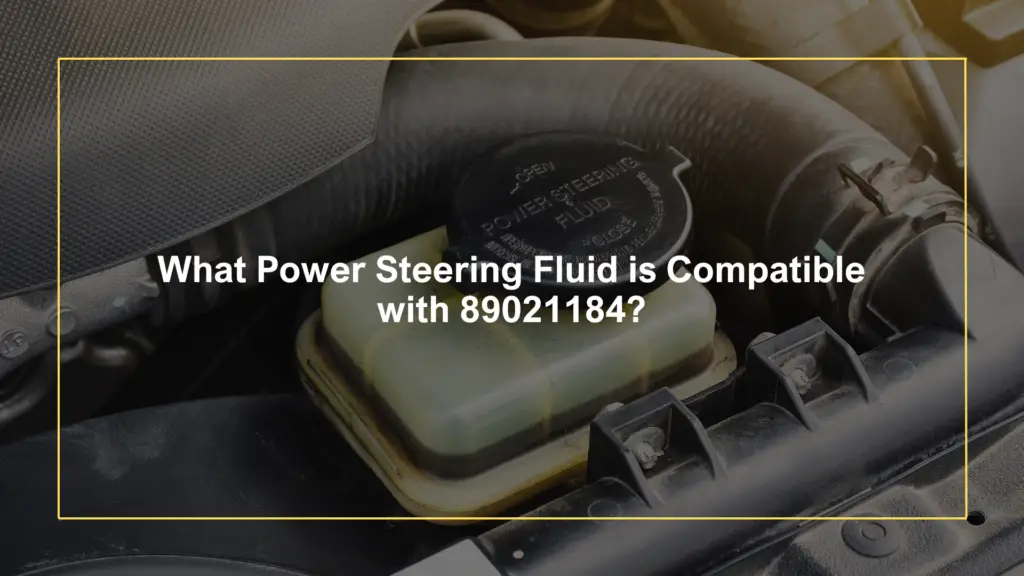Is your power steering fluid coming out of reservoir cap? What could have caused it, and how can you fix that?
The causes of this problem may come from the power steering fluid leak, the O rings failure, or air stuck in the power steering system. As a car owner, I know how much trouble this issue brings you!
Read on to understand more about these reasons that lead to this problem, how to fix them, and the cost of fixing them.
Let’s dive in!
Causes and Solution of Power Steering Fluid Coming Out Of Reservoir Cap

Air In The Power Steering System
Why Does Air Stuck In The System?
Air can get stuck in the power steering system due to low fluid level. In some vehicles (ex. Fords), if you quickly turn the steering when your engine is off, much pressure is exerted on the fluid in the reservoir, insomuch that the fluid is forced to shoot upwards and escape through the cap.
The other reason is that you did not close the reservoir cap carefully in your last change/ fill up the fluid. This can make air get into the system easily.
The most common signs that depict air in the power steering engine are stiff steering wheel, unusual moaning and groaning. Even though the fluid level is low, it will still overflow on shutoff.
How To Remove Air From The Power Steering System
1. Bleed The Power Steering System
This is the step-by step guide on how to bleed the power steering system
Step 1: Park your car in a level spot and turn the engine off.
Step 2: Raise the front end of your car with a jack and support it on jack stands.
Step 3: Find the power steering bleed screw on the power steering pump. The bleed screw is usually located on the back of the pump, near the top.
Step 4: Place a catch basin or small bucket under the power steering bleed screw.
Step 5: Loosen the power steering bleed screw with a wrench, being careful not to strip it.
Step 6: Turn the engine on and let it idle for a few minutes.
Step 7: As the engine is running, keep an eye on the power steering fluid level in the reservoir. If it starts to get low, add more fluid.
Step 8: Tighten the power steering bleed screw when the power steering fluid is free of air bubbles.
Step 9: Lower the car off of the jack stands and take it for a test drive.
2. Cover the Reservoir Cap
If the pressure hose is in good condition, it implies that air may have gotten in from the reservoir cap, which was not tightly closed. So, close the reservoir properly, and the issue is solved.
Related Post: What Power Steering Fluid Is Compatible With MS5931
Faulty Power Steering O-rings
Cause of O-rings Failure
Another possible reason why your vehicle’s power steering fluid is leaking is due to faulty O-rings. Most drivers typically overlook the O-rings, but they play a significant role in making your car function smoothly. The function of O-rings is simple; to block water or any liquid from escaping. There are many places where O-rings are used in a vehicle, and the power steering system is inclusive.
Just like other components in a car, the O-rings can get worse due to several reasons. The most common factor that affects the O-rings in a vehicle is aging. If your car is older, the primary O-rings it came with must have worn out. However, in rare situations, the O-rings may be affected by severe temperatures.
When the O-rings in the power steering system are faulty, it causes the power steering fluid to leak.
How To Fix Faulty O-Rings?
If you get faulty O-rings, all you need to do is replace them with new ones.
The power steering O-ring is on the top of the suction hose that transfers fluid from the reservoir into the power steering pump. To remove a component from the power steering system, you may need to disassemble the entire system.
Depending on your vehicle type and model, there are typically two O-rings in the power steering system. It is advisable to replace the two at a go (even though it’s just one that got bad). If you’d be doing it yourself, you need a clamp, a pair of gloves to cover your hands, clean rag or towel, and the new O-rings.
You will need to place the rage beneath the hose so that the little fluid that may pour out will not touch your belt or AC compressor when you take out the hose. Afterward, proceed to pullout the hose from the system and replace the O-rings.
Cost Of Replacing Faulty O-Rings
You can buy o-rings between $7 and $12 (shipping fee not included). The labor cost is between $50 – $70.
Note: When buying O-rings, ensure to inform the seller about your car model. O-rings are available in pairs, and they differ for different car models.
Related Post: What power steering fluid is compatible with 89021184?
Power Steering Fluid Leaks
There are other reasons why your power steering fluid leaks; the reasons are detailed below.
Power Steering Reservoir Cap Leaks
During time, your vehicle’s power steering reservoir cap may be broken due to severe impact, collision/accident, or age. This will make the PS fluid comes up when heated and pours away.
How To Check Power Steering Reservoir Cap Leaks
Simply allow the engine to cool down, take off the reservoir cap and look closely around the body. If you could see a physical crack, that’s the cause of the fluid leak. Also, if the cap is physically damaged (partly broken), you’d see that.
How to fix
The simple solution here is to replace the broken power steering cap. This is not an expensive repair, and it’s something you can do without involving anyone. Just remove the old cap and replace with a new one. Easy to do!
Cost Of Replacing a Bad Power Steering Cap
You’d get a new one between $3 – $10, depending on the design of your vehicle’s power steering system. The caps are available in various stores, or you can buy it online.
Cracked Reservoir
Sadly, the power steering fluid reservoir can crack and damage. Yes, this is possible due to several reasons, which include serious collisions. A cracked reservoir will let out fluids profusely.
Two major factors that can cause this to happen are “Time” and “Usage.” Time refers to the age of the vehicle, while usage refers to your driving style and how often you drive. If you had an accident, the severity could also cause the reservoir to crack.
How To Fix A Cracked Power Steering Reservoir
If the reservoir is not so cracked, you could easily glue it up. Replacing the reservoir itself is not recommended by most car manufacturers; however, some mechanics can help you do that if the plastic is badly cracked.
- Use Glue
Get strong glue and patch up the areas that are leaking. This is the best solution if the reservoir is not severely damaged. It is economical, and you can do it yourself easily.
- Replace the Tank
If the reservoir is badly damaged, you need to purchase another one (the exact one for your car model). The steps to replace the reservoir are pretty rigorous, and you need a set of tools; thus, it is best to get a mechanic to do that for you.
Cracked Power Steering Reservoir Repair Cost
If you go with the glue for your very minor crack, it will cost you around $7 for
The cost of replacing a broken power steering reservoir differs based on car models, year, type, and engine. However, the replacement costs between $150 – $600 (labor cost included).
Power Steering Hoses Leak
Typically, two hoses connect to the power steering system. These hoses are subjected to different pressures, and even though they are designed to withstand such forces, they become weaker as the years go by. When either of these two hoses is terrible, the fluid that passes through it will leak away.
Constant intense vibrations can cause the power steering hoses to rub against other components in the engine bay, which can result in leaks. More so, as the car gets older, the hose can be worn-out due to wear and tear.
How To Check Power Steering Hoses For Leaks
If your power steering hose(s) is leaking, you’d see thick grime around the area where the fluid leaks out. Also, you’d see oil drops on surrounding components like the AC compressor.
How To Fix Power Steering Hose Leaks
It’s simple; change the faulty hose. This is not like the reservoir you can patch up; if a hose is damaged, a total replacement is needed. You will have to lose a bunch of nuts to remove the old hose and install the new one; thus, it’s best to get a mechanic.
Power Steering Hose Leaks Repair Cost
To replace a power steering pressure hose costs between $400 and $450. The parts cost between $317 and $350, while the labor costs between $100 and $150.
Related Post: What is The Best PSF-3 Alternative?
Summary
When you see your power steering fluid coming out of the reservoir or leaking from the hoses, you need to inspect the entire system and replace the faulty components. Interestingly, the cost of fixing most power steering system components is below $150, which is quite affordable.
Finally, it is important to fix any issue with your vehicle’s power steering system as early as possible, before it escalates to costly repairs.
Did you find this blog post helpful? If so, could you share it with your friends?



Pingback: 6 Car Fluids That You Need to Check Regularly — Auto Trends Magazine